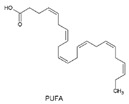Table 3.
The potential functions of the array of specialized metabolites encoded by Red Sea brine SMGCs. SMGCs are named as denoted by antiSMASH tool [45]. Hyphens indicate hybrid clusters. Cf_fatty_acid: fatty acid putative cluster. Cf_putative: unknown type putative cluster. Cf_saccharide: saccharide putative cluster. Hserlactone: cluster coding for homoserine lactone. Lantipeptide: cluster coding for lanthipeptide. NRPS: cluster coding for non-ribosomal peptide synthetase. OtherKS: cluster coding for other types of polyketide synthases. Pufa: cluster coding for poly-unsaturated fatty acids. T1pks: type I polyketide synthase. T2pks: type II polyketide synthase. T3pks: type III polyketide synthase.
| General Functional Classification: | Product (Enzyme) | Gene Cluster Names | Representative Basic Structure | Potential Function/Application of Product | Percentage of Total SMGCs | |
|---|---|---|---|---|---|---|
| 1. Products of predicted functions commonly abundant in microbes | Saccharide | Cf_saccharide Cf_saccharide-Bacteriocin Cf_saccharide-nrps Cf_fatty_acid-Cf_saccharide T3pks-cf_saccharide |
- | Microbe-host interactions e.g. lipopolysaccharides. Some saccharides that are diffusible were reported to have antibacterial activities [46,47]. | 80.61% | |
| Fatty Acid | Cf_fatty_acid Arylpolyene-cf_fatty_acid Cf_fatty_acid-Arylpolyene Cf_fatty_acid-Cf_saccharide Ladderane-Cf_fatty_acid T2pks-Cf_fatty_acid |
- | Structural functions and reported that composition can change as an adaptation to temperature and pressure in the environment [48]. | 7.69% | ||
| Aryl polyenes | Arylpolyene Arylpolyene-cf_fatty_acid Cf_fatty_acid-Arylpolyene |

|
Aryl polyene SMGCs found in abundance in Gram negative bacteria. Previously reported to have a protective role from damage caused by reactive oxygen species [46,49]. | 0.52% | ||
| Acyl-homoserine lactones | Hserlactone |

|
Quorum sensing [50]. | 0.03% | ||
| 2. Subset of products with potential antibacterial and/or anticancer effects: | Terpenes | Terpene |

|
A subset of the terpenes possesses antibacterial effect [51]. | 1.89% | |
| Peptides | Ribosomal peptides | Bacteriocin Cf_saccharide-Bacteriocin Microcin Lantipeptide |

|
Some have antibacterial activity, and some have selective cancer cytotoxic activity [52]. | 0.78% | |
| Non-ribosomal peptides | Cf_saccharide-nrps NRPS Nrps-T1pks |
- | Many non-ribosomal peptides have antibacterial (e.g., β-lactams) and anticancer (e.g. bleomycin) effects [53]. | 0.25% | ||
| Polyketides | (Type I Polyketide synthase) | Nrps-T1pks Otherks-Pufa-T1pks Otherks-T1pks T1PKS |
- | A subset are responsible for antibiotic synthesis e.g. the type I polyketide synthase (PKSI) producing erythromycin [54]. | 0.2% | |
| (Type II Polyketide synthase) | T2pks-Cf_fatty_acid | - | Some type II polyketide synthase (PKSII) enzymes produce aromatic polyketide antibiotics e.g. oxytetracycline [54]. | 0.09% | ||
| (Type III Polyketide synthase) | T3pks T3pks-cf_saccharide |
- | Type III Polyketide synthase (PKSIII) enzymes are capable of producing an array of compounds including pyrones—a subset of pyrones were previously reported to have antibacterial and anticancer effects [55]. | 0.31% | ||
| Phosphonates | Phosphonate |

|
Some natural phosphonates are antibacterials e.g. fosfomycin. Also have structural functions [56]. | 0.01% | ||
| 3. Miscellaneous: products are predicted to confer adaptation to the environment/special structure/unknown function: | Others | Cf_putative Other OtherKS Otherks-Pufa Otherks-Pufa-T1pks Otherks-T1pks |
- | Some code for biosynthetic gene clusters of types that are still unknown [9]. | 8.13% | |
| Polyunsaturated fatty acids | Otherks-Pufa Otherks-Pufa-T1pks |

|
Polyunsaturated fatty acids (PUFAs) are membrane adaptations to piezophiles, thermophiles and psychrophiles to prevent membrane crystallization [57,58]. | 0.14% | ||
| Ectoine | Ectoine |

|
Halophilic adaptation & effective in vitro in preventing protein misfolding characteristic in diseases e.g. Alzheimer’s [59]. | 0.08% | ||
| Ladderane | Ladderane-Cf_fatty_acid |

|
Unique component of anammoxosome membrane in anammox (anaerobic ammonium oxidizing) bacteria and potential biofuel [60]. | 0.05% | ||
